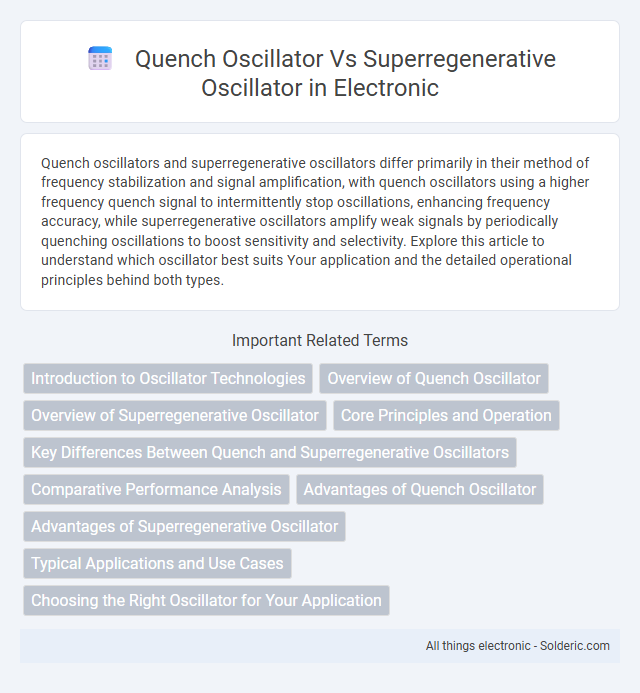Quench oscillators and superregenerative oscillators differ primarily in their method of frequency stabilization and signal amplification, with quench oscillators using a higher frequency quench signal to intermittently stop oscillations, enhancing frequency accuracy, while superregenerative oscillators amplify weak signals by periodically quenching oscillations to boost sensitivity and selectivity. Explore this article to understand which oscillator best suits Your application and the detailed operational principles behind both types.
Comparison Table
| Feature | Quench Oscillator | Superregenerative Oscillator |
|---|---|---|
| Oscillation Principle | Periodic quenching stops oscillations temporarily | Regeneration with periodic quenching for amplified oscillations |
| Frequency Range | Low to mid frequency, typically up to MHz | Wide, from RF to UHF bands (MHz to GHz) |
| Applications | Signal generation, timing circuits | Radio receivers, low-power transmitters |
| Q-Factor | Moderate quality factor | Very high effective Q due to superregeneration |
| Complexity | Simple circuit design | More complex, requires careful control of quench frequency |
| Signal Stability | Moderate stability | Higher sensitivity but lower frequency stability |
| Power Consumption | Low power | Generally low but can vary with frequency and gain |
Introduction to Oscillator Technologies
Quench oscillators utilize a transistor switch that rapidly turns on and off to generate oscillations, making them ideal for high-frequency radar and communication applications. Superregenerative oscillators extend this concept by incorporating a feedback loop with controlled quenching to amplify weak signals and improve sensitivity in radio receivers. Understanding the operational principles of both types helps optimize your design for specific frequency stability and signal detection requirements.
Overview of Quench Oscillator
A quench oscillator operates by periodically disabling the oscillation to control frequency, enabling stable high-frequency signal generation. It typically uses a quenching transistor to interrupt the main oscillator, enhancing frequency stability and reducing phase noise. This design contrasts with superregenerative oscillators, which rely on self-quenching through feedback to achieve greater sensitivity but with higher distortion.
Overview of Superregenerative Oscillator
Superregenerative oscillators use controlled quenching to periodically reset the oscillation, allowing for high sensitivity and simple design in radio frequency detection. They typically operate with a quench oscillator that modulates the main oscillator, enhancing signal gain while reducing noise. Your choice between a quench oscillator and superregenerative oscillator depends on application requirements such as sensitivity, complexity, and frequency stability.
Core Principles and Operation
Quench oscillators operate by periodically interrupting the oscillation at a high frequency, modulating the main oscillation to generate a controlled waveform, which is essential in applications like FM demodulation and pulse generation. Superregenerative oscillators enhance sensitivity and selectivity by using a quenching signal to periodically reset the regenerative feedback, allowing the circuit to amplify weak signals while preventing sustained oscillations. Both oscillators rely on the principle of controlled oscillation interruption, but quench oscillators emphasize waveform modulation, whereas superregenerative oscillators focus on signal amplification and detection.
Key Differences Between Quench and Superregenerative Oscillators
Quench oscillators operate by periodically interrupting the oscillation to reset the circuit, enhancing frequency stability and reducing noise, while superregenerative oscillators amplify weak signals through rapid regeneration and quenching cycles for higher sensitivity. Your choice depends on application needs: quench oscillators prioritize stable, low-noise output in RF circuits, whereas superregenerative oscillators offer simplicity and increased gain for signal detection despite higher distortion. Frequency range, stability, and signal purity are critical factors distinguishing these two oscillator types.
Comparative Performance Analysis
Quench oscillators typically offer higher frequency stability and lower phase noise compared to superregenerative oscillators, making them suitable for applications requiring precise signal generation. Superregenerative oscillators provide superior sensitivity and simple circuit design, resulting in higher gain but at the cost of increased noise and less frequency stability. Your choice between the two depends on whether performance priorities favor signal clarity or sensitivity in low-cost, energy-efficient designs.
Advantages of Quench Oscillator
Quench oscillators offer higher stability and reduced noise compared to superregenerative oscillators, making them more suitable for precise signal generation and detection. They provide better frequency control and improved performance in low-power applications, which enhances efficiency in wireless communication systems. Their design simplicity also enables easier integration into compact circuits without compromising signal quality.
Advantages of Superregenerative Oscillator
Superregenerative oscillators offer higher sensitivity and improved selectivity compared to quench oscillators, making them ideal for weak signal detection in RF applications. Their ability to achieve significant gain with fewer components results in simpler, more cost-effective circuit designs. You benefit from enhanced signal amplification and reduced power consumption in compact, efficient setups.
Typical Applications and Use Cases
Quench oscillators are commonly employed in radio frequency and communication circuits for generating low-frequency signals with improved stability, making them ideal for amplitude modulation and frequency synthesis. Superregenerative oscillators excel in low-power, short-range wireless applications such as remote controls and RFID systems due to their high sensitivity and simple design. Your choice between these oscillators depends on whether you prioritize signal stability or energy-efficient detection in your electronic application.
Choosing the Right Oscillator for Your Application
Quench oscillators offer better stability and lower phase noise, making them ideal for applications requiring precise frequency control such as radar and communication systems. Superregenerative oscillators provide higher sensitivity and simpler circuitry, suited for low-power, short-range wireless devices like remote controls and low-cost receivers. Selecting the right oscillator depends on balancing the need for signal clarity, power consumption, and complexity based on the specific application requirements.
quench oscillator vs superregenerative oscillator Infographic

 solderic.com
solderic.com